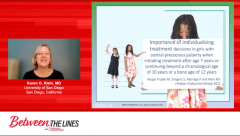
Vargas Trujillo CPP Study Review: Overview and Baseline Characteristics
Karen O. Klein, MD, provides an overview of CPP (central precocious puberty) as well as a review of the study design and baseline characteristics from the Vargas Trujillo et al study on the importance of individualizing treatment decisions in girls with CPP.
Episodes in this series
Karen O. Klein, MD: Hello. My name’s Dr Karen Klein from the University of California San Diego in San Diego, California. And I will be discussing a Journal Club article today. The title is “Importance of individualizing treatment decisions in girls with central precocious puberty when initiating treatment after age 7 years or continuing beyond a chronological age of 10 years or a bone age of 12 years.” The first author is Dr Marcela Vargas Trujillo, one of my colleagues at the University of California San Diego. This program is sponsored by AbbVie. I need to disclose that the contents are consistent with all applicable FDA guidelines. I’ve been selected by AbbVie, and I’m presenting on their behalf.
We will do a quick overview of central precocious puberty, [CPP] as background to the Journal Club discussion. Central precocious puberty occurs when the hypothalamic-pituitary-gonadal axis is activated prematurely, which leads to increased gonadal steroid hormone secretion, which leads to the physical and hormonal changes seen in children with precocious puberty. We’re going to use the classic definition of onset of puberty as less than 8 years of age in girls, and less than 9 years of age in boys. The signs, as I’ve mentioned, include the physical secondary characteristics, and accelerated bone maturation and growth. We usually define this as at least progression of 1 pubertal stage or Tanner stage per year and a bone age that’s at least 2 standard deviations beyond the chronological age—it’s out of the normal range—and a growth rate consistent with the stage of puberty. The consequences, if left untreated, of central precocious puberty can lead to the changes of physical development that aren’t consistent with peers, and the problems that come with that; the risk of premature menarche, and then the long-term consequences: premature fusion of the growth plates and reduction of adult short stature. Early diagnosis and prompt referral help ensure the best possible treatment outcomes.
Gonadotropin releasing hormone agonists are the standard of care for treating central precocious puberty. With that background, looking at the paper, which is a new retrospective analysis of leuprolide depot data…we can look at these 2 main points. We don’t have a lot of published data. Looking at when treatment is started—before a chronological age of 7, or continued past a chronological age of 10, or a bone age of 12—we wanted to examine the height outcomes in girls with central precocious puberty, when treatment is initiated at a chronological age greater than 7, as well as continued past a bone age of 12.There are 2 knowledge gaps on the spectrum of treating children with central precocious puberty. The study design was based on a large study with 1 monthly injection of depot leuprolide. We have 48 treatment-naïve girls from that study. We only included girls, so that the numbers could have statistical power, since not as many boys were in the study. We took the 48 girls. They had to have breast onset before 8 years of age, a peak stimulated LH [luteinizing hormone] to define central puberty greater than 10 years of age. It was a very robust definition to make sure these were true rapidly-progressing girls with central puberty. All the girls had a chronological age of less than 9 years of age at the beginning of the study, and a bone age of at least 1 year advanced. They were screened and then started on treatment, where they received monthly doses based on their weight at that time, and had monthly examinations, a physical exam and laboratory testing, bone age measurement, and safety measures were applied. And then after the end of treatment, they had a long follow-up period, where they had a visit every 6 months until they reached pubertal levels and then annual visits or questionnaires until the age of 21. We also have long-term outcome published data from this population. But for the purposes of this paper, we wanted to look back at this robust data source and look at the changes in predicted adult height and growth rate between the girls who started treatment at less than age 7 and greater than 7 years of age, and between the girls with bone ages greater than 12 or less than 12. The statistical analyses were straightforward, with correlations between the variables assessed by linear regression, and then changes over time, from baseline, using paired t-tests. All the values are presented as mean plus standard deviations unless otherwise noted. And the software was SAS [statistical analysis system] version 9.4. Table 1 shows the baseline characteristics of race, ethnicity, mean chronological age, which—you can see the mean age was 6.8, but the range was from a girl that was 1 year old to a girl who was 9 years old, the upper limit of our inclusion criteria. The breast stages are shown here, so that you can see most of them. Fifty percent were stage 3—in the middle of puberty. And then the other important thing on this table is how advanced the bone age actually was. There are a couple of ways to look at it. The bone age to chronological age ratio, average 1.5. The difference in bone age and chronological age averaged 3 years. Significantly advanced bone age predicted adult height and midparental height are shown here—obviously with great discrepancy.
Transcript Edited for Clarity
Newsletter
Access practical, evidence-based guidance to support better care for our youngest patients. Join our email list for the latest clinical updates.








